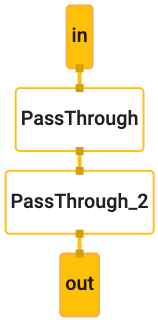Sie benötigen eine funktionierende Version des MediaPipe-Frameworks. Siehe Installationsanleitung.
So führen Sie das Beispiel
hello worldaus:$ git clone https://github.com/google/mediapipe.git $ cd mediapipe $ export GLOG_logtostderr=1 # Need bazel flag 'MEDIAPIPE_DISABLE_GPU=1' as desktop GPU is not supported currently. $ bazel run --define MEDIAPIPE_DISABLE_GPU=1 \ mediapipe/examples/desktop/hello_world:hello_world # It should print 10 rows of Hello World! # Hello World! # Hello World! # Hello World! # Hello World! # Hello World! # Hello World! # Hello World! # Hello World! # Hello World! # Hello World!Im Beispiel
hello worldwird ein einfaches MediaPipe-Diagramm in der FunktionPrintHelloWorld()verwendet, das in einemCalculatorGraphConfig-Proto definiert ist.absl::Status PrintHelloWorld() { // Configures a simple graph, which concatenates 2 PassThroughCalculators. CalculatorGraphConfig config = ParseTextProtoOrDie<CalculatorGraphConfig>(R"( input_stream: "in" output_stream: "out" node { calculator: "PassThroughCalculator" input_stream: "in" output_stream: "out1" } node { calculator: "PassThroughCalculator" input_stream: "out1" output_stream: "out" } )");Sie können dieses Diagramm mit MediaPipe Visualizer visualisieren, indem Sie den CalculatorGraphConfig-Inhalt unten in den Visualizer einfügen. Hilfe zum Visualizer finden Sie hier.
input_stream: "in" output_stream: "out" node { calculator: "PassThroughCalculator" input_stream: "in" output_stream: "out1" } node { calculator: "PassThroughCalculator" input_stream: "out1" output_stream: "out" }Diese Grafik besteht aus 1 Grafikeingabestream (
in) und 1 Grafikausgabestream (out) sowie zwei nacheinander verbundenenPassThroughCalculator.
Bevor die Grafik ausgeführt wird, wird ein
OutputStreamPoller-Objekt mit dem Ausgabestream verbunden, um später die Grafikausgabe abzurufen. Außerdem wird die Diagrammausführung mitStartRungestartet.CalculatorGraph graph; MP_RETURN_IF_ERROR(graph.Initialize(config)); MP_ASSIGN_OR_RETURN(OutputStreamPoller poller, graph.AddOutputStreamPoller("out")); MP_RETURN_IF_ERROR(graph.StartRun({}));Im Beispiel werden dann mit der Funktion
MakePacket10 Pakete erstellt (jedes Paket enthält den String „Hello World!“ mit Zeitstempelwerten zwischen 0, 1, ... 9) und fügt jedes Paket über den Eingabestreaminin die Grafik ein. Anschließend wird der Eingabestream geschlossen, um die Ausführung des Diagramms zu beenden.for (int i = 0; i < 10; ++i) { MP_RETURN_IF_ERROR(graph.AddPacketToInputStream("in", MakePacket<std::string>("Hello World!").At(Timestamp(i)))); } MP_RETURN_IF_ERROR(graph.CloseInputStream("in"));Über das Objekt
OutputStreamPollerruft das Beispiel dann alle zehn Pakete aus dem Ausgabestream ab, ruft den Stringinhalt aus jedem Paket ab und gibt ihn im Ausgabelog aus.mediapipe::Packet packet; while (poller.Next(&packet)) { LOG(INFO) << packet.Get<string>(); }
Sofern nicht anders angegeben, sind die Inhalte dieser Seite unter der Creative Commons Attribution 4.0 License und Codebeispiele unter der Apache 2.0 License lizenziert. Weitere Informationen finden Sie in den Websiterichtlinien von Google Developers. Java ist eine eingetragene Marke von Oracle und/oder seinen Partnern.
Zuletzt aktualisiert: 2024-05-14 (UTC).
[{
"type": "thumb-down",
"id": "missingTheInformationINeed",
"label":"Benötigte Informationen nicht gefunden"
},{
"type": "thumb-down",
"id": "tooComplicatedTooManySteps",
"label":"Zu umständlich/zu viele Schritte"
},{
"type": "thumb-down",
"id": "outOfDate",
"label":"Nicht mehr aktuell"
},{
"type": "thumb-down",
"id": "translationIssue",
"label":"Problem mit der Übersetzung"
},{
"type": "thumb-down",
"id": "samplesCodeIssue",
"label":"Problem mit Beispielen/Code"
},{
"type": "thumb-down",
"id": "otherDown",
"label":"Sonstiges"
}]
[{
"type": "thumb-up",
"id": "easyToUnderstand",
"label":"Leicht verständlich"
},{
"type": "thumb-up",
"id": "solvedMyProblem",
"label":"Mein Problem wurde gelöst"
},{
"type": "thumb-up",
"id": "otherUp",
"label":"Sonstiges"
}]

